- Heritage
- Hits: 2702
An illustrated wine glossary I
Illustrations – Steven Millington
Illustrations – Steven Millington
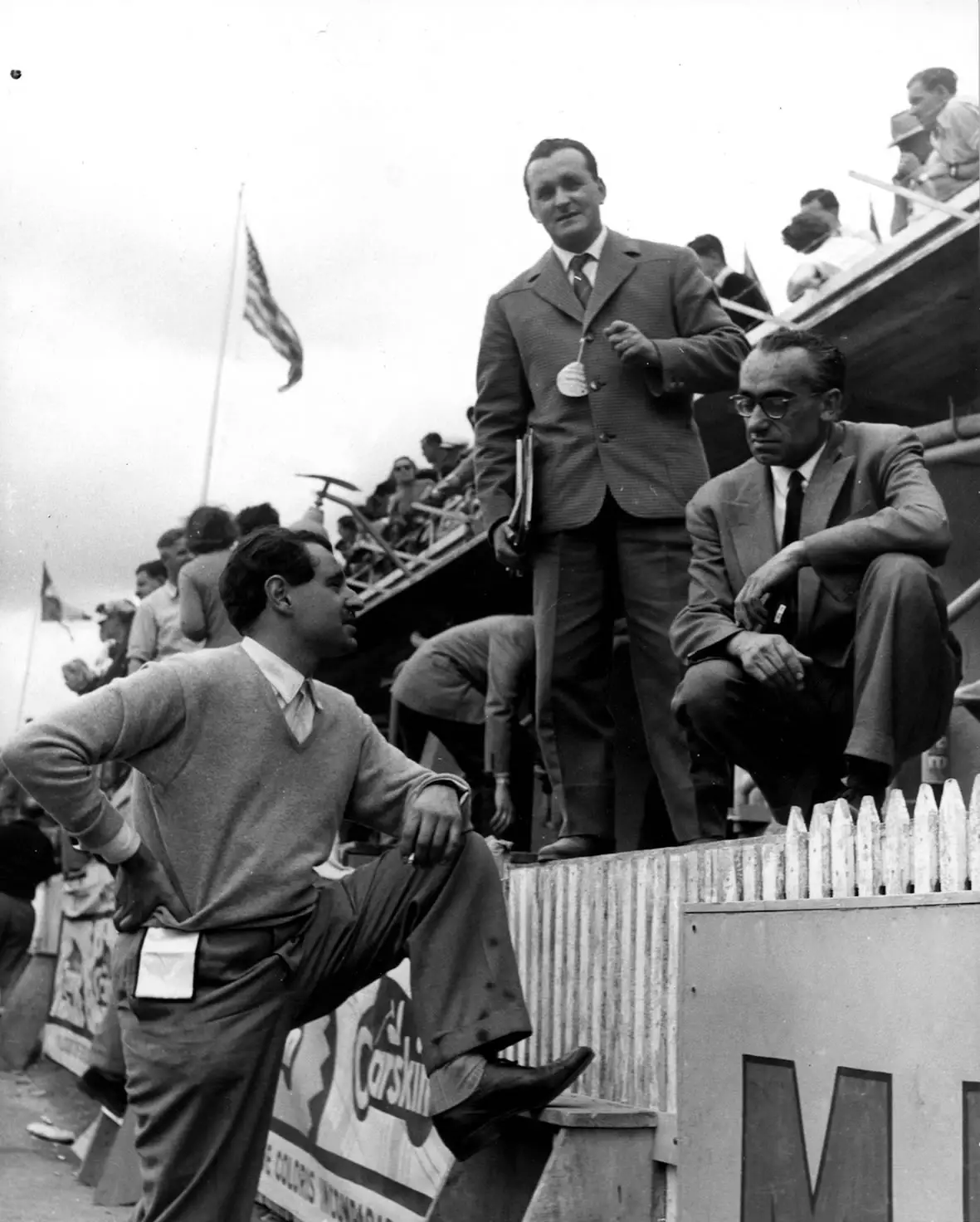 There is a reason why Enzo Ferrari described Mille Miglia as ‘the most beautiful race in the world’. It is more than a simple car race: for many years it has represented a chance for the whole of Italy to come together and celebrate its own collective heritage and an occasion to acknowledge our shared past. That’s why Federico Fellini chose to include it in his masterpiece Amarcord. The Marzotto family has long recognized its own key business values as embedded at the very core of this event, which celebrates boldness and innovation. Their presence at Mille Miglia was initially of a competitive nature, as brothers Vittorio, Umberto, Giannino and Paolo raced against legendary pilots such as Fangio and Ascari. To this day, Marzotto’s presence is guaranteed, as the race reaches the 34th installment of its historical re-enactment.
There is a reason why Enzo Ferrari described Mille Miglia as ‘the most beautiful race in the world’. It is more than a simple car race: for many years it has represented a chance for the whole of Italy to come together and celebrate its own collective heritage and an occasion to acknowledge our shared past. That’s why Federico Fellini chose to include it in his masterpiece Amarcord. The Marzotto family has long recognized its own key business values as embedded at the very core of this event, which celebrates boldness and innovation. Their presence at Mille Miglia was initially of a competitive nature, as brothers Vittorio, Umberto, Giannino and Paolo raced against legendary pilots such as Fangio and Ascari. To this day, Marzotto’s presence is guaranteed, as the race reaches the 34th installment of its historical re-enactment.
Can any other event in the world combine tradition, excitement and beautiful landscapes like Mille Miglia? This is the question – a rhetorical one of course – behind the thirty-fourth re-enactment of this historical race, scheduled to take place between May 19th and May 22nd: it is enough to explain why this legendary competition never lost its appeal. Enzo Ferrari summed up this happy, colorful trail of cars, which seems to exist out of time, in a clever two-word definition: ‘traveling museum’. Only cars that have been constructed between 1927 and 1957 are allowed to take part in the competition today. Back in its first instalments, Mille Miglia was all about the fastest car, today is more about endurance. Above all, however, Mille Miglia is about history – not only of car engineering, but of Italy as a whole. This is a race that goes beyond the simple thrill of competitive driving, to celebrate made-in-Italy excellence. That’s why the Santa Margherita Wine Group chose to sponsor it for the second year in a row.
The history of the Marzotto family is closely connected to the race: in the Fifties the four Marzotto brothers – Vittorio, Umberto, Giannino and Paolo – regularly competed in the Mille Miglia, often triumphing over established champions such as Fangio and Ascari. In 1954, Vittorio Marzotto came first in his category, behind the wheel of a Ferrari Sport 500 Mondial, qualifying for the silver medal overall, just behind Formula 1 champion Alberto Ascari. Just two years earlier, he’d won the prestigious Grand Prix of Monaco.
This year too the Marzotto family is in attendance. The Santa Margherita Wine Group is putting forward five cars, among the nearly 450 participating vehicles, from 36 different countries. On the Santa Margherita team there are two Lancia Aurelia B20’s, one driven by Stefano Marzotto and Mauro Peruzzi, and one driven by Nicolò Marzotto and Santa Margherita’s CEO Ettore Nicoletto; a Lancia Aurelia B24 driven by Giuseppe Giuliano and Loris Vazzoler, the Group's Tecnhical Director; a Mercedes Gullwing driven by Formula 1 champion Ivan Capelli and Steve Slater; a Lancia Lambda driven by Alessandro and Sebastiano Marzotto. Stefano Marzotto explained why his family has a soft spot for Lancia: “First of all, Lancia is a very important brand historically. It enabled Ferrari to put together a great Formula 1 team. Right after the tragic death of Ascari, Lancia left the racing world and handed his great inheritance over to Ferrari. That included all the technology that the brand had developed up to that point, in many cases more advanced than Ferrari’s own. Lancia has always been our family car of choice. We ran our first race on a Lancia Aprilia.”
The Marzotto family, however, brought home its first trophies with Ferrari: Giannino won the Mille Miglia in 1950 and 1953, behind the wheel of his signature Ferrari ‘Uovo’. “My family and Enzo Ferrari,” Stefano Marzotto continues, “had a very close relationship. This was back when Ferrari was a very different company from what it is today. Back then, the Marzotto family directly contributed to the brand’s development. We’d purchase one of their cars, and their owner would pay the workers. Soon we started racing with their cars.” This sparked some rivalry among the participants to the Mille Miglia. “Enzo was reserving his best cars for the pilots on his team. We were a bit of a secondary, unofficial team – so when we beat them, it was a big deal.”
This sparked some rivalry among the participants to the Mille Miglia. “Enzo was reserving his best cars for the pilots on his team. We were a bit of a secondary, unofficial team – so when we beat them, it was a big deal.”
In 2016, Mille Miglia is going to re-enact the four-legs of the original route, over four days. The starting line is set in Brescia, on Thursday May 19th, followed by Rimini the next day and ending in Rome. On the third day drivers will loop back up to Parma, returning to Brescia on Sunday May 22nd. “It’s our very own Tour de France,” 1000 Miglia’s Andrea Dalledonne happily sums up the race, “It’s the best of Italy on show.” He is right, as increasingly participants, partners and punters come from abroad. “I’m really impressed with the interest we’ve generated internationally – although at times it feels like other countries are more excited about this race than Italians should be themselves. Eighty percent of our sponsors and racers are foreign. That’s why it’s so important to us to keep up our strong relationships with Italian partners, such as the Santa Margherita Wine Group.”
Of course, as well as the historical bond between the Marzotto family and 1000 Miglia, there are obvious marketing strategies put in place as part of the sponsorship agreement. “Many of our wine cellars are located in the areas the race passes by: it’s a new way for our customers to get to know these places, and observe our work up close.” It is also a way to generate live participation, the kind of live support that makes Mille Miglia a really special race. A growing, all-encompassing passion that works across generations and is propelled by a deep awe for these minor miracles of mechanics and design, able to travel faster than 200km/h. “This is a popular event – in the real sense of the word,” Dalledonne continues, “the kind you see granddads taking their grandsons to. When you watch competitive cycling there is a quick flash of color and then it’s all over. Mille Miglia is much more fun to watch because the parade goes on for hours.” And how could you get bored, given the backdrop against which it takes place? “Driving into Rome last year was incredible,” says Stefano Marzotto: “It was a truly spectacular May evening, the kind that makes you feel joy deep in your heart, in its utter simplicity.” And if anyone, after all this, still had any qualms regarding the contemporary value of Mille Miglia, let us answer them with a memorable quote from Giannino Marzotto: “When you celebrate the past you need to ask yourself why. Mille Miglia represented the technical and social progress of humanity: that’s why this re-enactment of the past is still relevant in helping us build a better future.”
Testo – Francesco Paolo Giordano
It all began in 1935 with Gaetano Marzotto. This story dates back more than 80 years and it is about love for the territory and a constant drive for innovation. Here are the main events and people that have marked Santa Margherita as an international success.
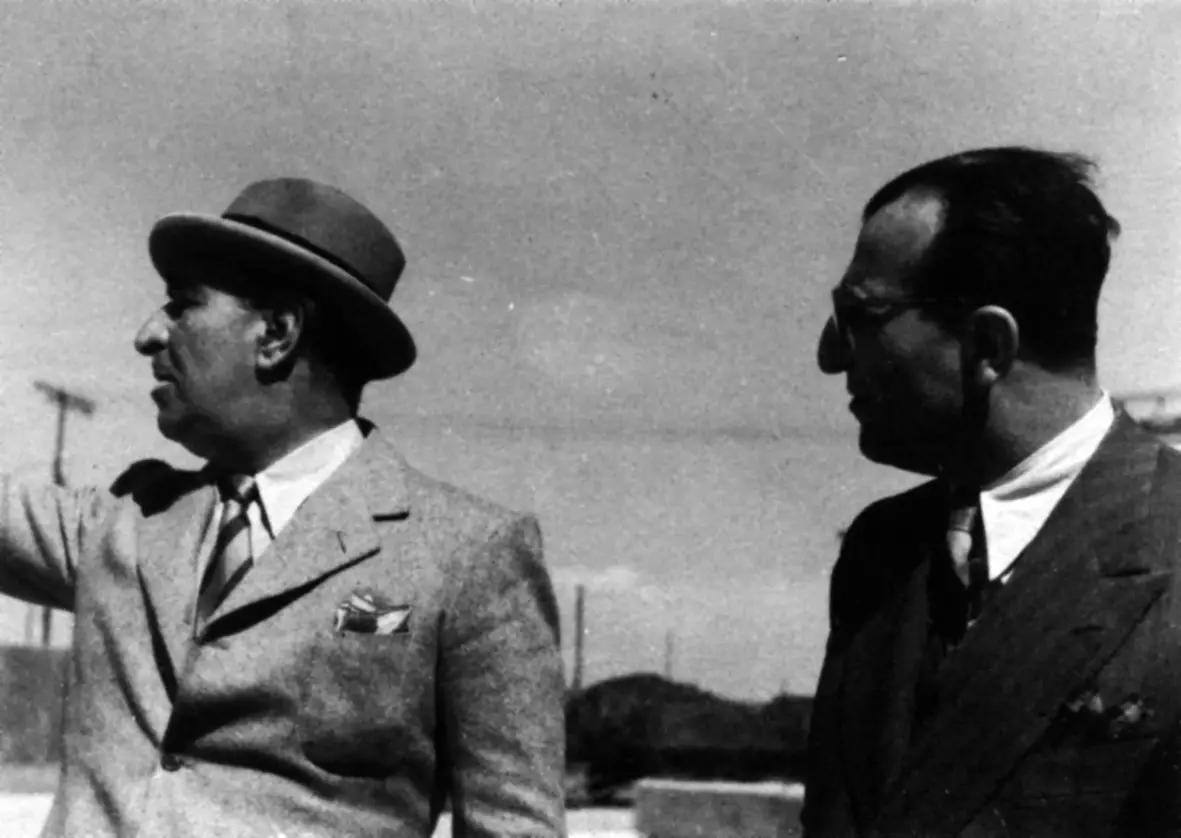
Gaetano Marzotto leads the company’s transformation from an agricultural to an agro-industrial business venture: the Portogruaro estate becomes a laboratory where his dream of modernizing Italian agriculture takes shape. Gaetano lays the foundations of what will become a true ‘wine mosaic’. The tesserae that would compose this mosaic are Italy’s best wine making districts: Eastern Veneto, the Adige valley, the hills of Valdobbiadene and Refrontolo, the Alto Adige area, Ca’ del Bosco’s Franciacorta, the Chianti Classico estates of Lamole di Lamole and Vistarenni, the Tuscan Maremma estate of Tenuta Sassoregale and Sicily’s Terrelíade.
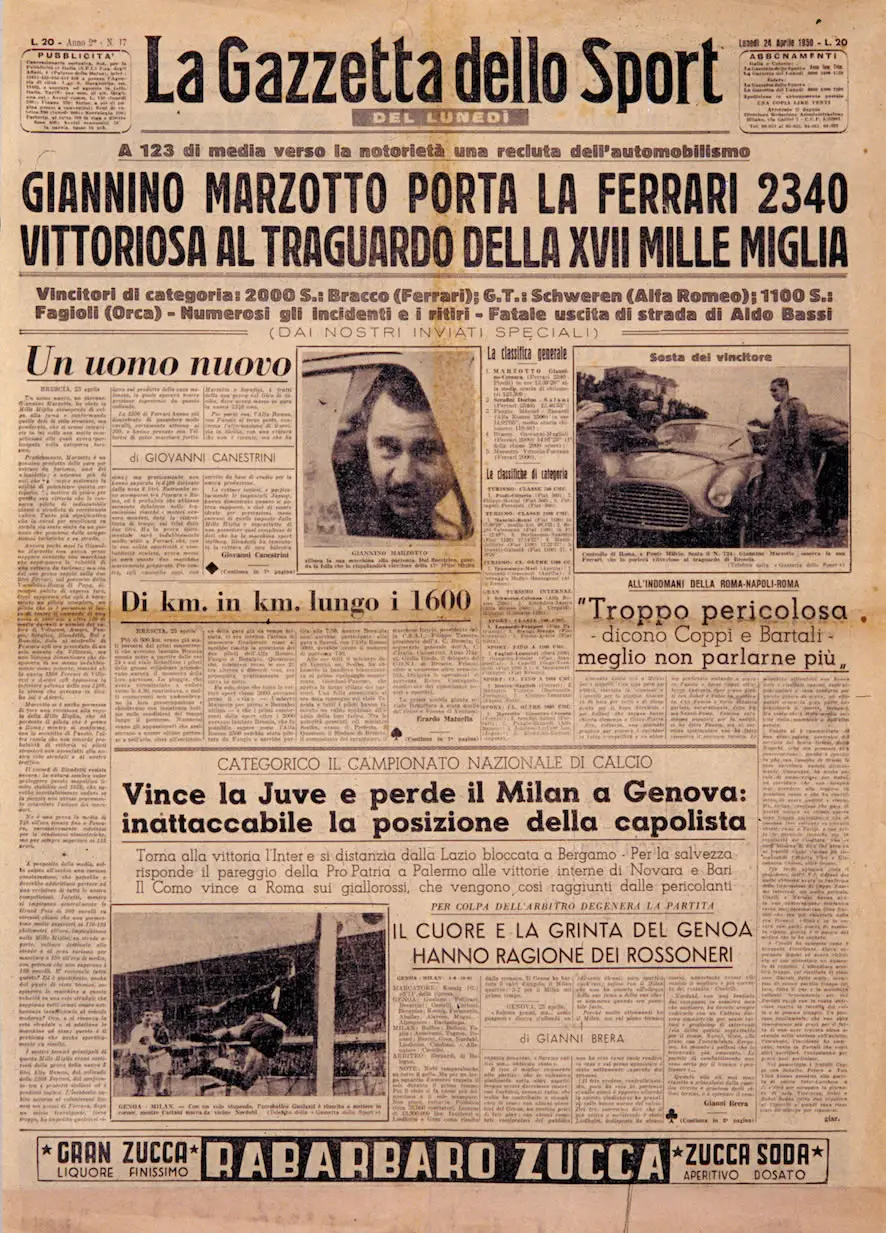
In the Fifties, the four Marzotto brothers – Vittorio, Umberto, Giannino e Paolo – are renamed Conti Correnti (the Racing Counts) by the media: four amateur pilots who became legends of European car racing. Giannino Marzotto is the winner of two editions of the Mille Miglia, in 1950 and 1953. In 1954 it is Vittorio who conquers the podium with a Ferrari Sport 500 Mondial. Aside from the Mille Miglia the Marzotto brothers competed with varying success in celebrated races such as Le Mans, the Dolomites Gold Cup Race, the Giro di Sicilia, and won the prestigious Monaco Grand Prix.
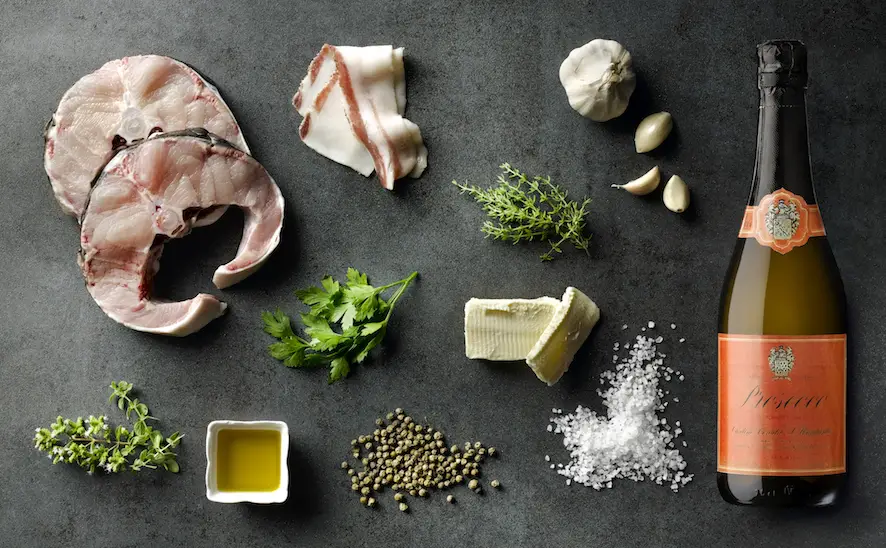
This is the year that sees the first sparkling vinification of Prosecco Valdobbiadene, today Prosecco Superiore di Valdobbiadene DOCG. Santa Margherita’s special relationship with Prosecco began quite sometime before it achieved the great popularity it enjoys today. In the space of a few decades the company has succeed in transforming a local product into a truly global phenomenon.
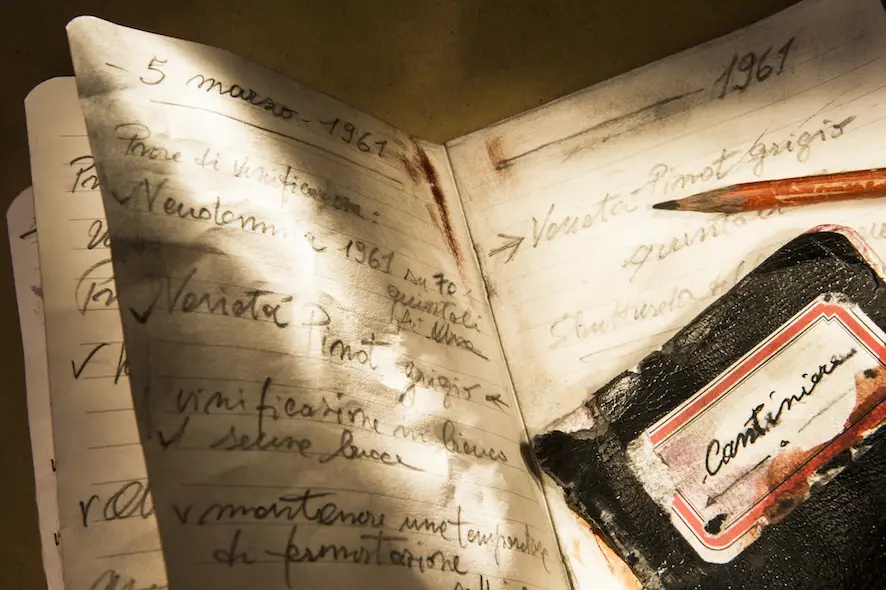
Santa Margherita’s technical team develops a process from which white wine can be obtained using the Pinot Grigio grapes of Trentino Alto Adige, with their typical rust-colored skins. Thus, a new generation of high-quality wines is born, thanks to continuous investments in oenological research and advanced manufacturing technologies. Wines that express all the freshness of the fruit and are incredibly versatile when it comes to food pairing. Pinot Grigio changed the rules of the game becoming one of Italy’s prized exports and conquering important foreign markets such as the United States.
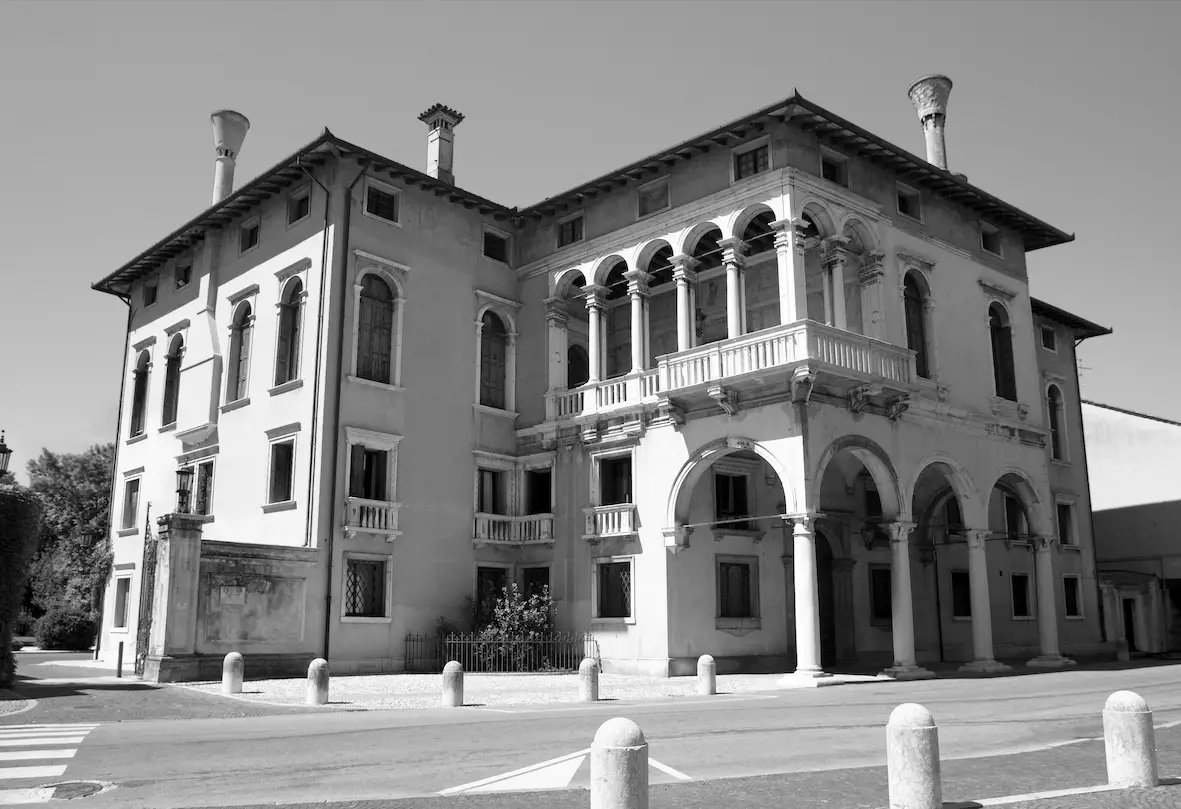
The company’s wine making enterprise is separated from the family’s other manufacturing activities and acquires the name of Santa Margherita Spa. The new logo is a stylized graphic Renaissance design of the beautiful Villa Marzotto in Portogruaro, built in 1540. A Venetian architectural jewel which to this day features on all of Santa Margherita’s wine labels.
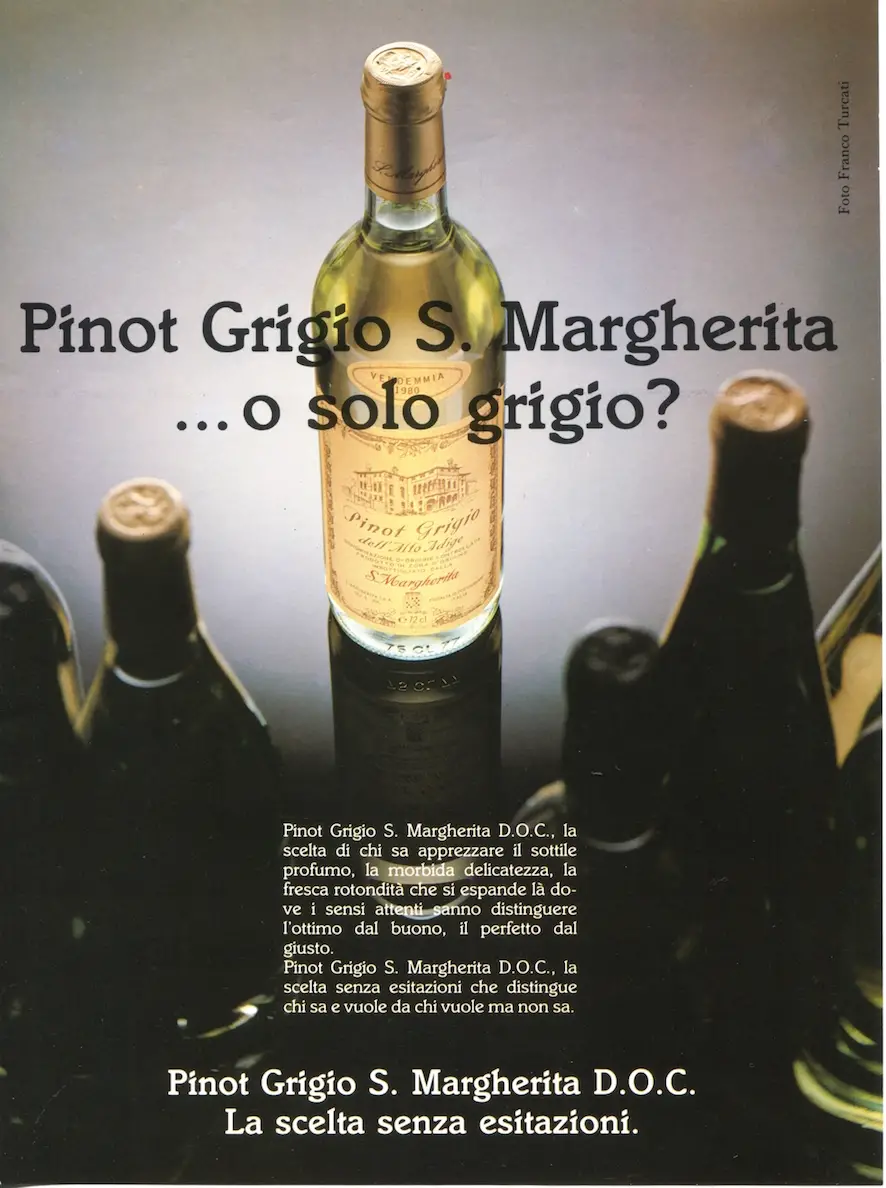
The company entrusts its advertising campaign to the creative and innovative genius of Emanuele Pirella who creates for Pinot Grigio Santa Margherita D.O.C the unforgettable slogan: “The choice that distinguishes those who can and will from those who would but don’t know how.”
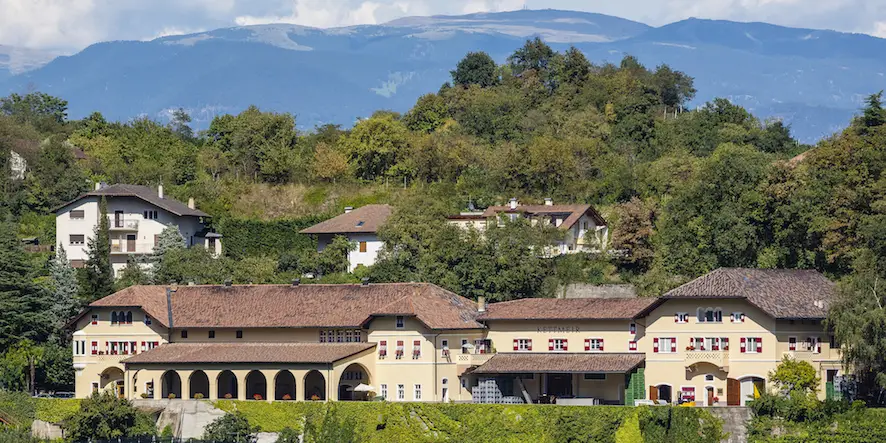
Kettmeir is the first new piece added to the wine-mosaic envisioned by Gaetano Marzotto: this is, in fact, the year in which this winery becomes part of the Santa Margherita family. Founded in 1919 by Giuseppe Kettmeier, the estate has remained true to the age-old wine tradition of its area, and under Santa Margherita’s leadership it has become a leading force in the modernization of wine making processes, trialling new technological advances in vinification and bottling.
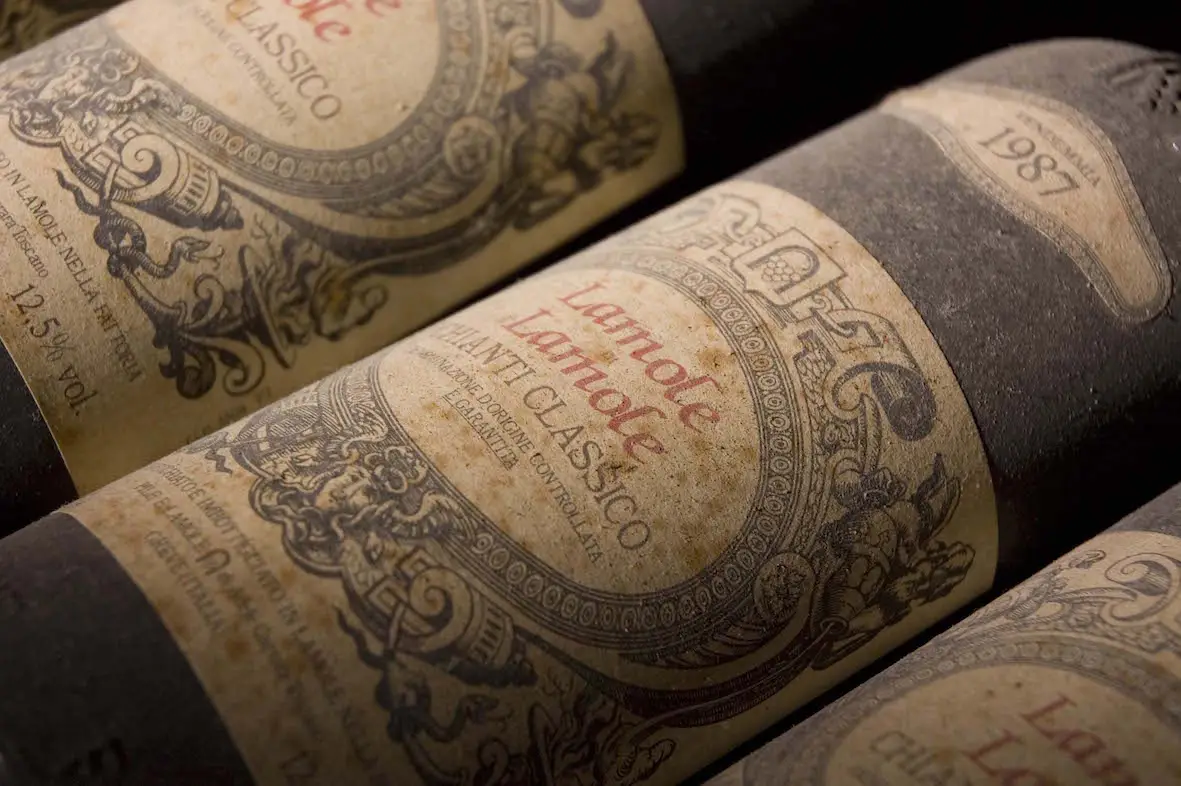
The Santa Margherita Group continues its expansion by welcoming Lamole di Lamole into the family. The Tuscan estate is immersed in a unique landscape at an altitude of over 500 meters, one of the highest elevations found in the district that produces Chianti Classico. The unique temperature range of this area, its sun and wind exposure allow these organically farmed vineyards to achieve the optimal ripeness of the grapes and give the wine its elegance, richness and lingering aromas.
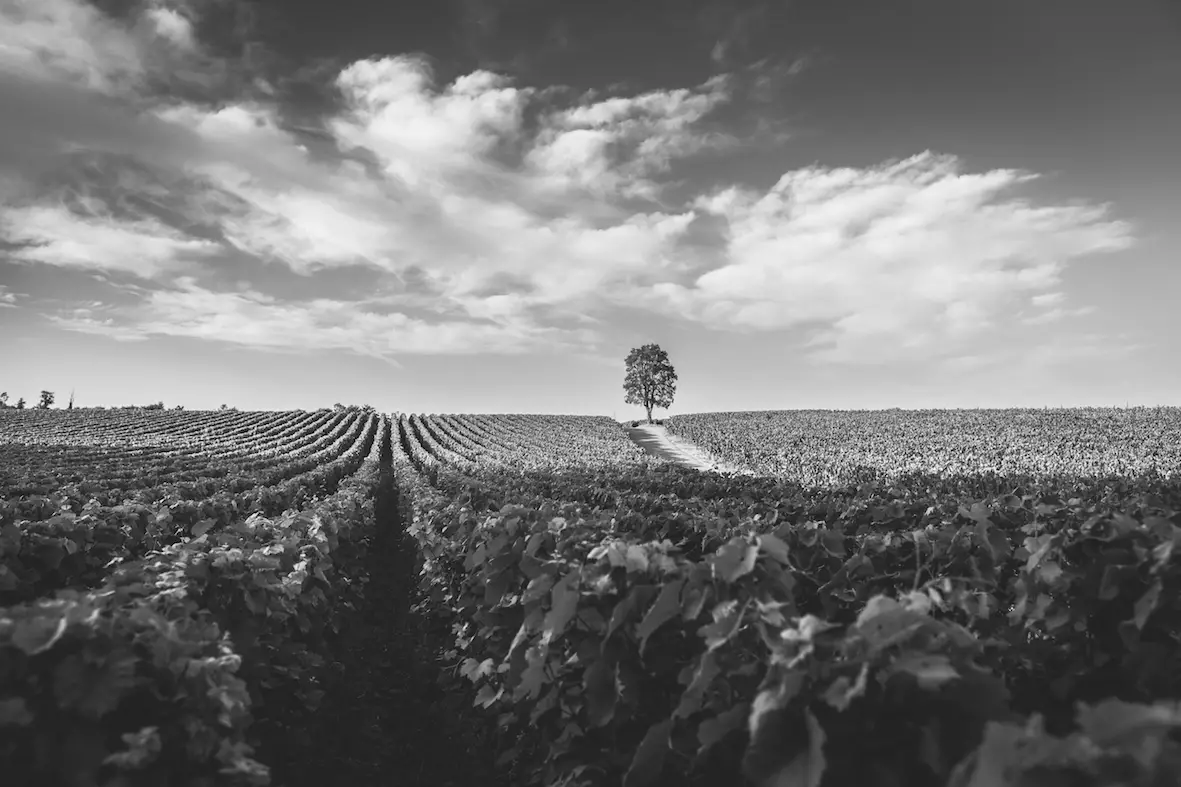
Another piece is added to Santa Margherita’s wine mosaic: Franciacorta Ca’ del Bosco, state of the art in the Franciacorta's production, thanks to the original patents developed to improve grape treatment and obtain perfect oxygen management.
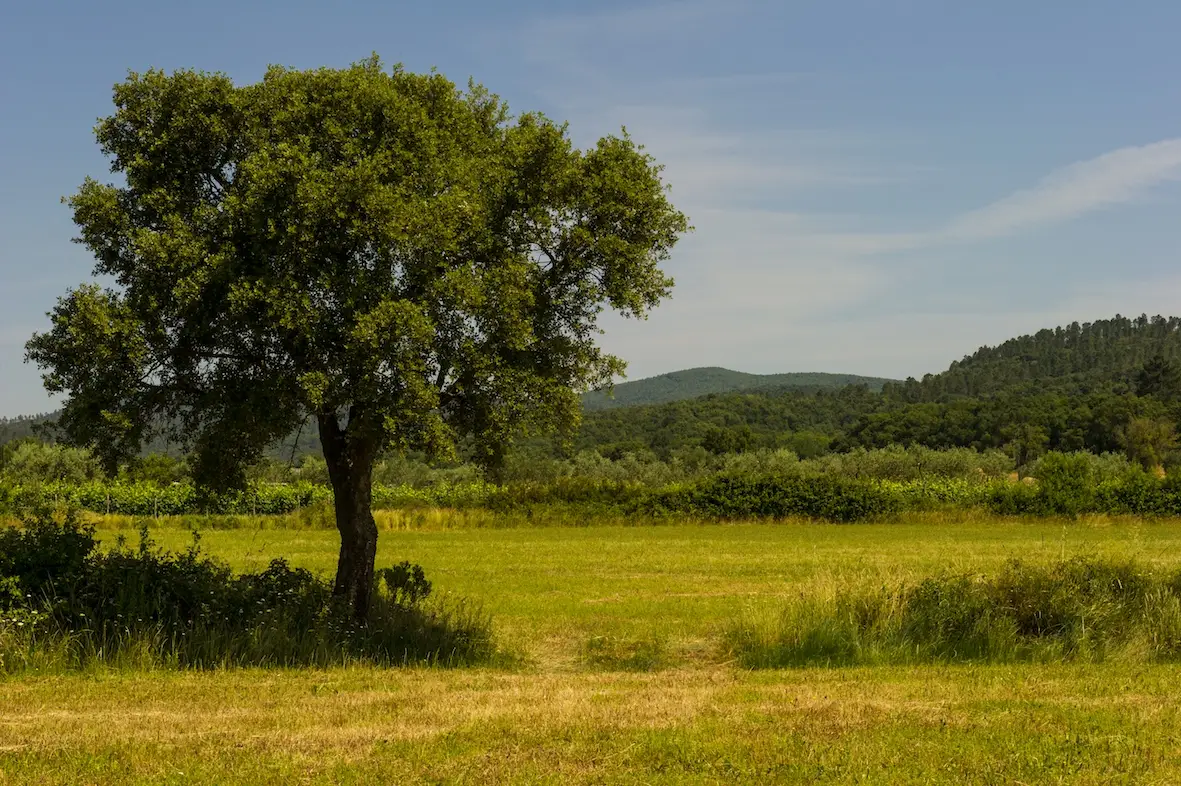
After Lamole di Lamole, a new Tuscan estate becomes a part of Santa Margherita’s wine mosaic: the Tenuta Sassoregale in the province of Grosseto. Blessed by a unique heritage in terms of biodiversity, the area possesses a distinctive food and wine culture awaiting to be discovered and valued. These original and elegant wines are produced from 38 hectares of land surrounded by Maremma’s unspoilt forests.
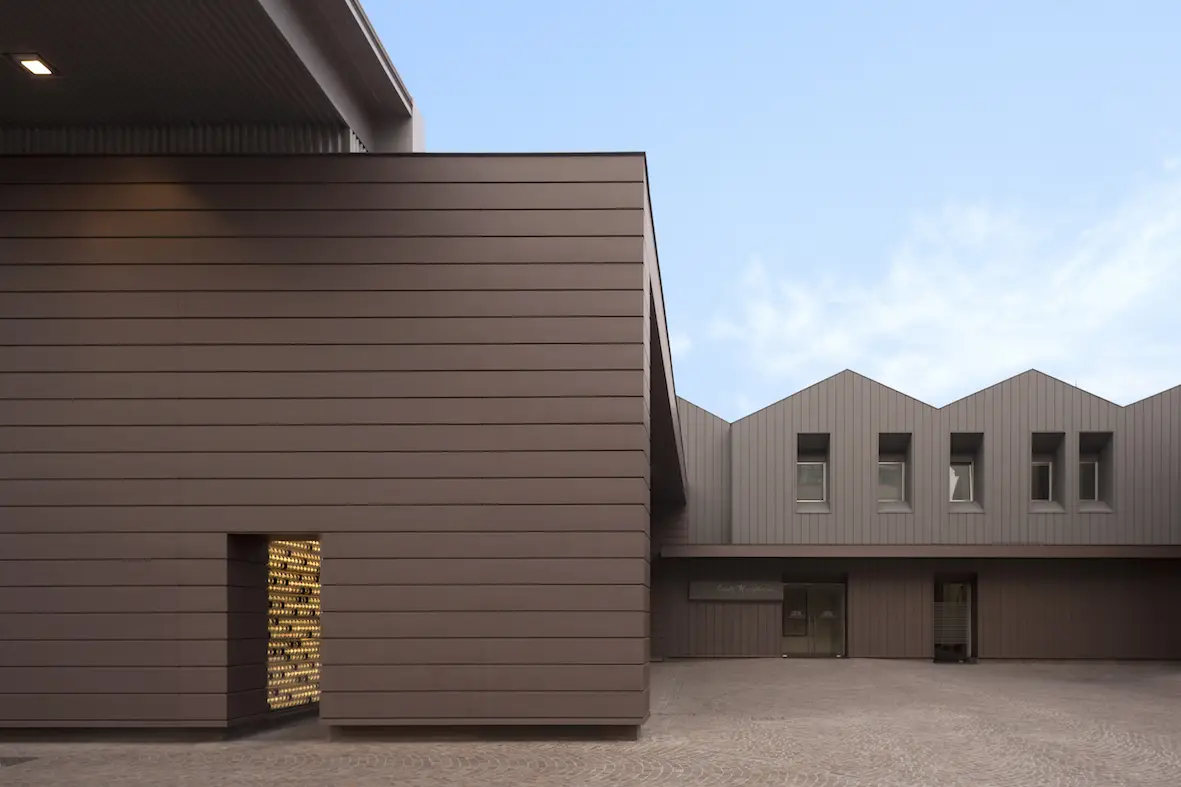
This year sees the opening of the new Villanova Cantina di Fossalta in Portogruaro, a renewed and expanded estate that confirms Santa Margherita as one of the most important wine producers in Italy. A firm commitment to wine excellence that is based on strong ties to local communities, in line with the Company’s distinctive dedication to social and industrial development.
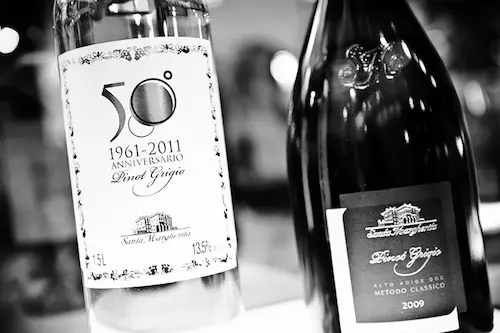
Pinot Grigio turns 50! In recent years this varietal has become the emblem of Italian white wine in the world and Santa Margherita continues to be its ambassador, thanks to the unwavering pioneering spirit that constantly seeks to create wines that embody all the qualities and character of their vineyards. The dialogue with each label’s geographical and cultural environment is the basis for the continuing growth of the brand. Combining craftsmanship, tradition and technological innovation has allowed Santa Margherita to further strengthen the important wine-terroir nexus and perfect a fresh and versatile Pinot Grigio that is ideally suited to be enjoyed as an accompaniment to a wide range of dishes.
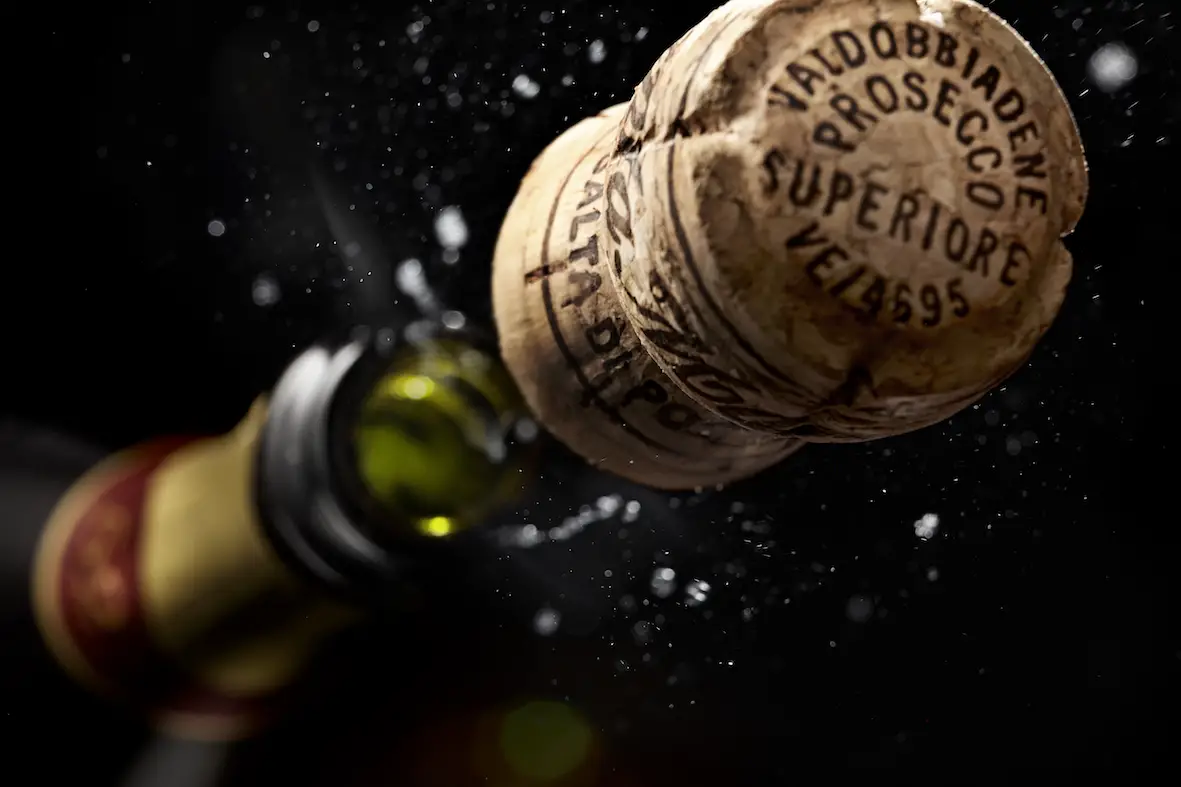
Prosecco is experiencing a moment of particular success in international markets, and Santa Margherita’s Prosecco celebrates the 60th anniversary of its pioneering sparkling wine making method. It was in 1952 that Santa Margherita, innovating the traditional processing techniques of Prosecco grapes, perfected the sparkling Prosecco we enjoy today, thus helping to build the foundations of its international success. No bottle is more deserving of celebration than the Prosecco Superiore “52”, the result of a sophisticated and elegant grape selection which results in a fresh and young bubbly, with its signature bright straw-yellow colour, intense notes of peach and acacia, the soft and lingering mousse and fine perlage.
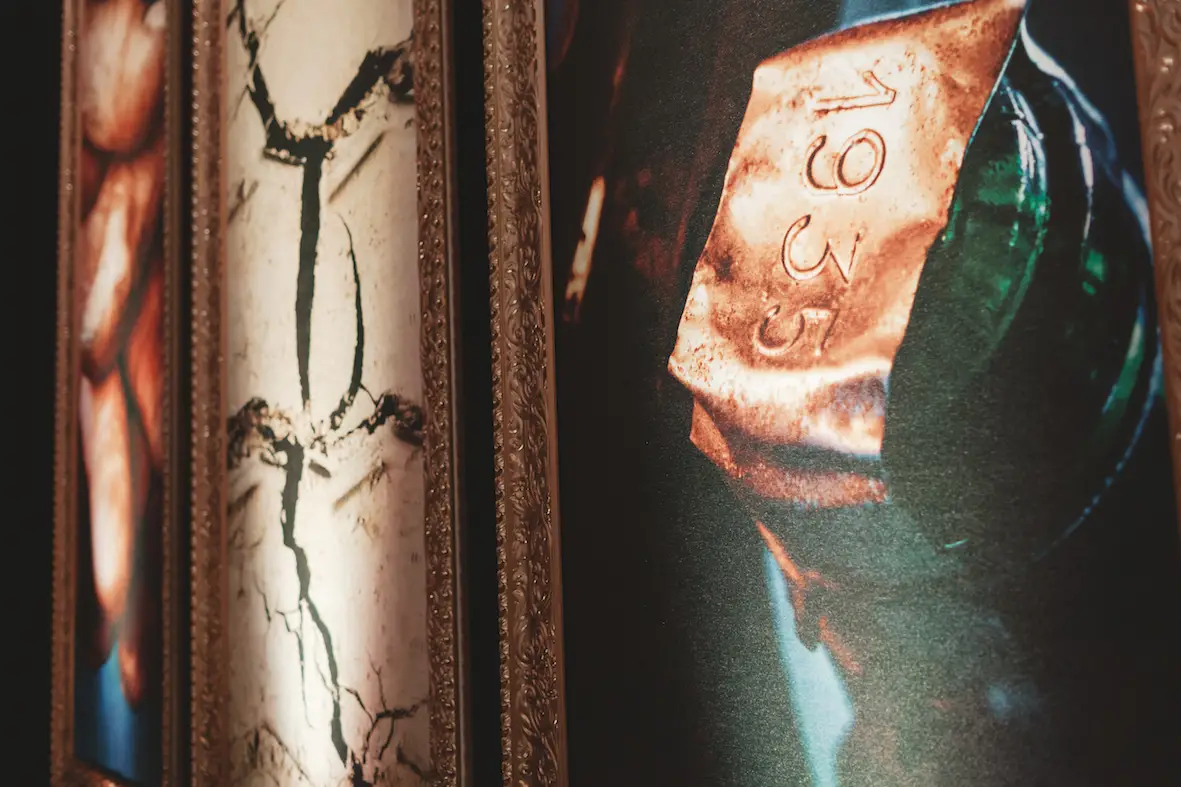
An important milestone for the Gruppo Vinicolo Italiano, that celebrates its eightieth anniversary, renewing its commitment to innovation achieved through sustainable practice in all aspects of wine making. The estate has achieved complete energetic self-sufficiency, thanks to the use of renewable sources, and has succeed in eliminating more than 923 potential tons of CO2 from the atmosphere every year. Santa Margherita has invested in the elimination of synthetic compound use from the vineyards, the reduction of wasteful water consumption, and maintains a firm commitment towards reforestation and the protection of biodiversity.
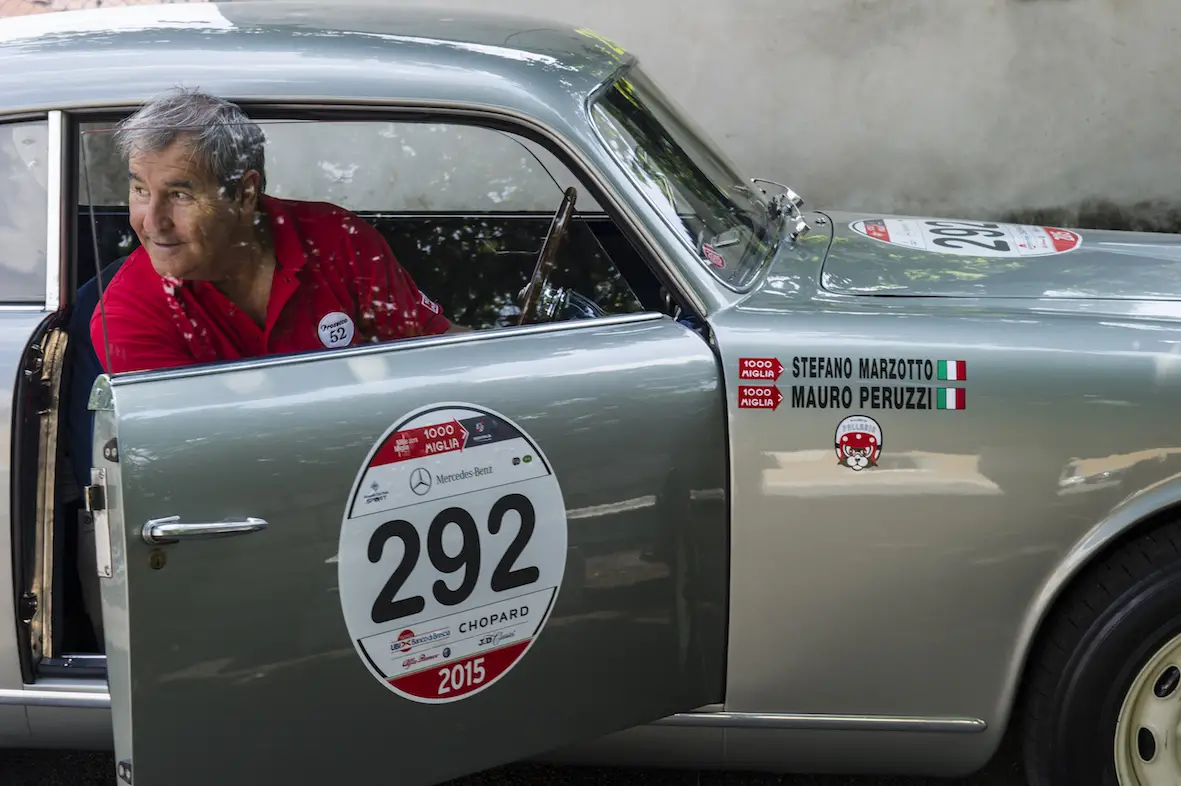
Santa Margherita is the main sponsor of the Mille Miglia vintage-car racing competition, and enters the 2015 edition with three crews to celebrate the eightieth anniversary of the brand. In this way, the company consolidates the special bond that, since the 1950s, the Marzotto family has shared with this competition, a race that combines old-style glamour, history and authentic popular appeal. Santa Margherita participates to the race with Stefano Marzotto driving the legendary Aurelia B20 of 1953.
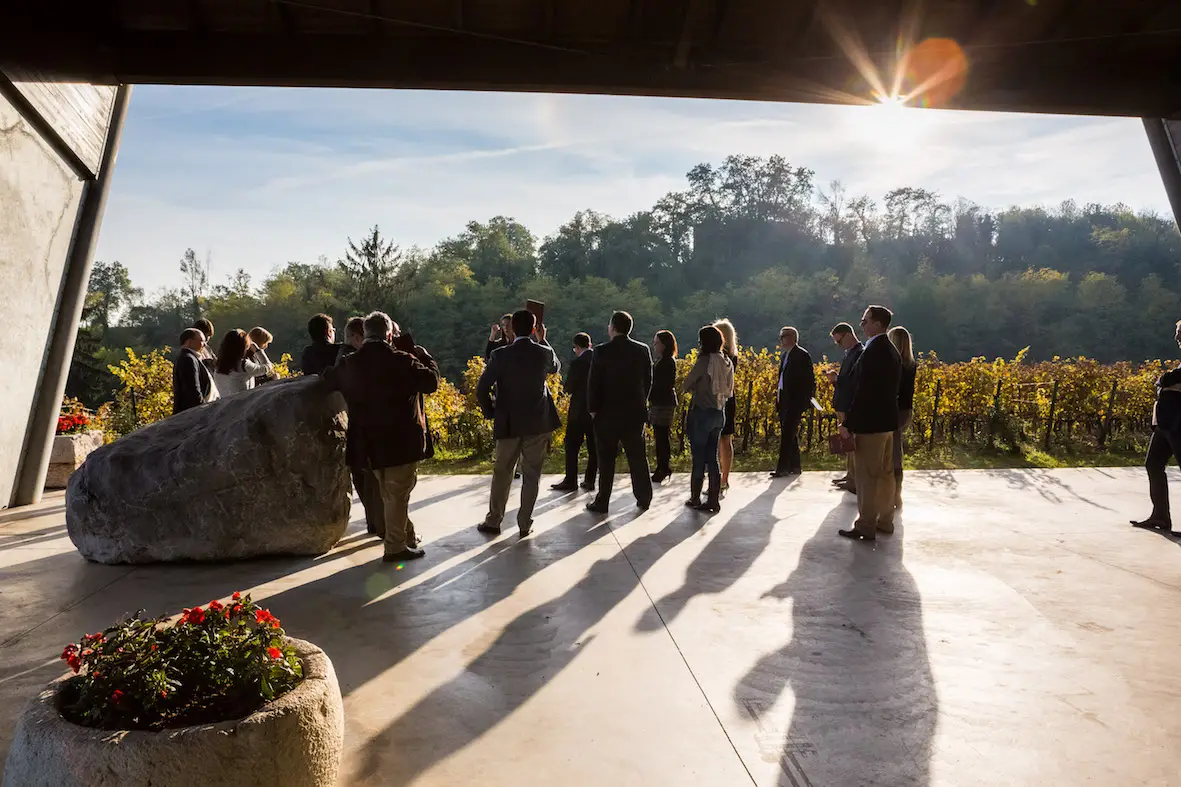
Since January 1st of this year the company directly oversees the entire management of the brand’s commercial activities and exports to the United States. With the launch of its Familiarization Tour in October 2015 a new path towards the in-house management of this enterprise begins, and Santa Margherita’s American team is accompanied on a tour of all the company’s Italian estates, a wonderful chance to really get to know each wine but also the local history and unique territory that has created it.
 Long and narrow roads that cut through farmlands, a low skyline blurred by the fog, old farmhouses scattered on the land; this is the landscape you see as you travel from Venice to Portogruaro. Venice is at once close and distant from here. The cultural splendor of the city reaches these lands, but this is a territory with its own specific characteristics, a land of products and of production that for centuries has been La Serenissima's larder. The agro-industrial complex of Villanova Santa Margherita and Torresella are located respectively to the east and south-east of Portogruaro, if you are driving down the SS14. It is a "new" development, uniquely shaped like few other Italian realities by an industrial and dynastic history, that of the Marzotto's and their ideas about work and society.
Long and narrow roads that cut through farmlands, a low skyline blurred by the fog, old farmhouses scattered on the land; this is the landscape you see as you travel from Venice to Portogruaro. Venice is at once close and distant from here. The cultural splendor of the city reaches these lands, but this is a territory with its own specific characteristics, a land of products and of production that for centuries has been La Serenissima's larder. The agro-industrial complex of Villanova Santa Margherita and Torresella are located respectively to the east and south-east of Portogruaro, if you are driving down the SS14. It is a "new" development, uniquely shaped like few other Italian realities by an industrial and dynastic history, that of the Marzotto's and their ideas about work and society.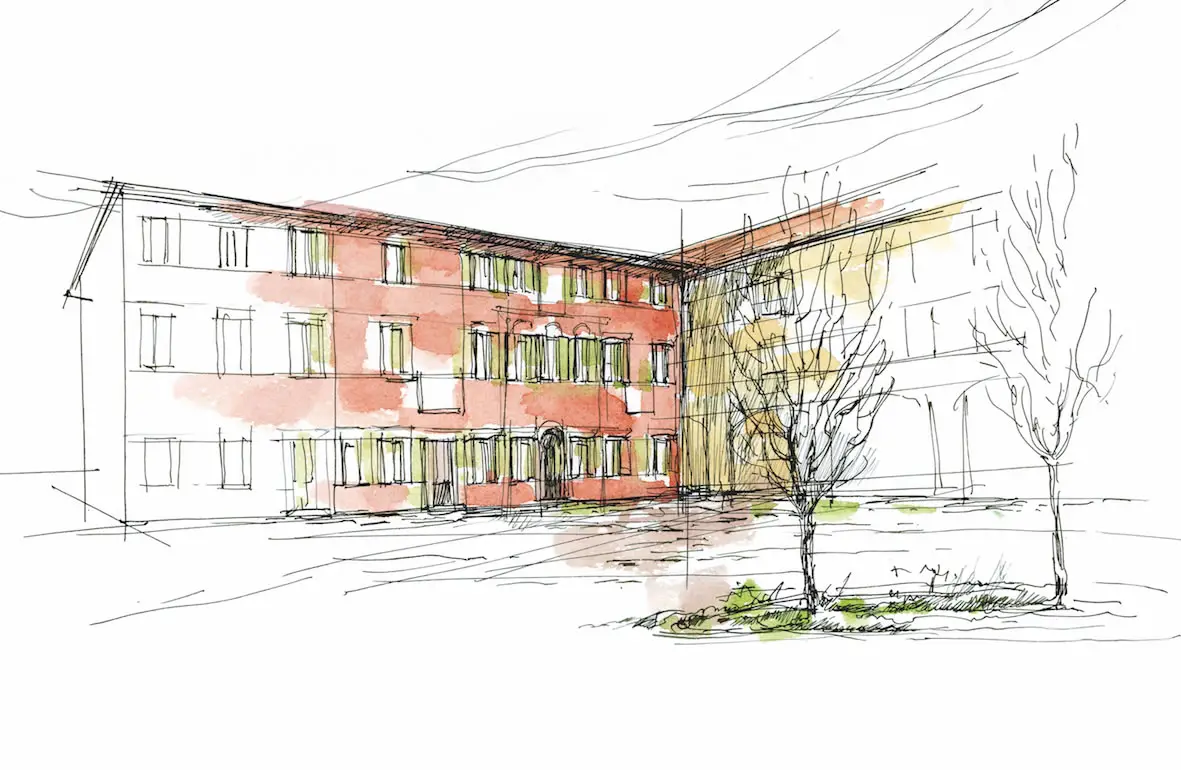 It all began with a farming estate of more than one thousand hectares. The land, acquired by Gaetano Marzotto in 1934, was previously owned by the Stucky family, which had reclaimed the marshy terrain in the 1920s. Marzotto’s plan was to incorporate it into a new agricultural hub with integrated activities and state of the art productive systems, completing the overall reclamation of this wetland area. The model of inspiration was clearly Valdagno (in the province of Vicenza), the place where in 1836 the Marzotto family had established a wool manufacturing company, transforming a cottage industry into a modern enterprise, while at the same time completely rethinking the local architectural and functional layout. Valdagno is the base from which the history of one of Italy's most legendary entrepreneurial families began. The story dates as far back as the eighteenth century with the commerce of wool, leading, about a century later, to the creation of a manufacturing company, under the leadership of Luigi Marzotto, the son of the family's first Gaetano. But it is thanks to Gaetano Jr. that Valdagno’s mills became Italy's greatest industrial success story.
It all began with a farming estate of more than one thousand hectares. The land, acquired by Gaetano Marzotto in 1934, was previously owned by the Stucky family, which had reclaimed the marshy terrain in the 1920s. Marzotto’s plan was to incorporate it into a new agricultural hub with integrated activities and state of the art productive systems, completing the overall reclamation of this wetland area. The model of inspiration was clearly Valdagno (in the province of Vicenza), the place where in 1836 the Marzotto family had established a wool manufacturing company, transforming a cottage industry into a modern enterprise, while at the same time completely rethinking the local architectural and functional layout. Valdagno is the base from which the history of one of Italy's most legendary entrepreneurial families began. The story dates as far back as the eighteenth century with the commerce of wool, leading, about a century later, to the creation of a manufacturing company, under the leadership of Luigi Marzotto, the son of the family's first Gaetano. But it is thanks to Gaetano Jr. that Valdagno’s mills became Italy's greatest industrial success story.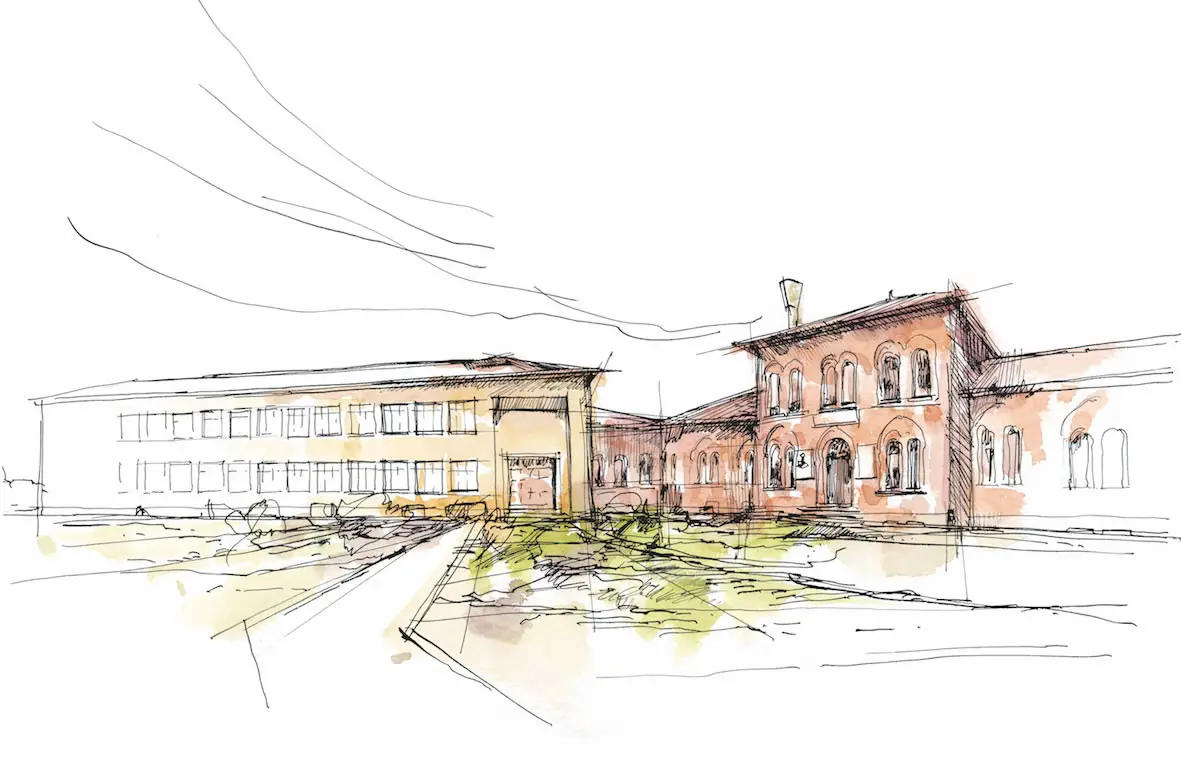 By restoring the machinery and reorganizing labor—a real obsession for Gaetano who was influenced by the new scientific approaches to labor being developed in the United States—he was able to transform the Marzotto factory into Europe's most efficient wool manufacturer. By the second half of the 1930s, the Valdagno factory had become the leading national manufacturing industry and the number one Italian textile exporter worldwide. All this optimization, however, transformed a part of the workforce into surplus (an estimated two thousand redundancies) and it is also for this reason that Gaetano Marzotto began to think of new activities through which to re-employ the Valdagno workers. In the Stucky estate, he saw the perfect opportunity to further develop and diversify the family business. At the time, Villanova was a poorly developed area, divided among small farm lease-holders for whom subsistence farming was the norm. The main crops were maize, beets and potatoes. The heart of the estate was and still is the casa Rossa. It stands today as a benevolent monument to Italy's agricultural and industrial history as well as being the symbolic center of the Marzotto business, situated alongside the cellar where one of Italy's best selling wines is produced. Under Gaetano Marzotto’s leadership, Villanova Santa Margherita grew impetuously from the 1940s onward. Modern machinery for land reclamation and agriculture were introduced. In addition to agricultural production, new livestock systems were implemented (animals had so far only been used to work the land), as well as sugar, glass, and soap factories and a cotton mill. The idea was to create an integrated and synergic system of supply chains. To name just a few examples: the wine would be bottled using the locally produced glass; the soap factory would make use of the waste products from other activities; the sugar factory could provide and outlet for the locally grown beetroot. It is here, that Italy's first industrially made fruit juice was produced. All in all, a total of twelve industrial plants were built.
By restoring the machinery and reorganizing labor—a real obsession for Gaetano who was influenced by the new scientific approaches to labor being developed in the United States—he was able to transform the Marzotto factory into Europe's most efficient wool manufacturer. By the second half of the 1930s, the Valdagno factory had become the leading national manufacturing industry and the number one Italian textile exporter worldwide. All this optimization, however, transformed a part of the workforce into surplus (an estimated two thousand redundancies) and it is also for this reason that Gaetano Marzotto began to think of new activities through which to re-employ the Valdagno workers. In the Stucky estate, he saw the perfect opportunity to further develop and diversify the family business. At the time, Villanova was a poorly developed area, divided among small farm lease-holders for whom subsistence farming was the norm. The main crops were maize, beets and potatoes. The heart of the estate was and still is the casa Rossa. It stands today as a benevolent monument to Italy's agricultural and industrial history as well as being the symbolic center of the Marzotto business, situated alongside the cellar where one of Italy's best selling wines is produced. Under Gaetano Marzotto’s leadership, Villanova Santa Margherita grew impetuously from the 1940s onward. Modern machinery for land reclamation and agriculture were introduced. In addition to agricultural production, new livestock systems were implemented (animals had so far only been used to work the land), as well as sugar, glass, and soap factories and a cotton mill. The idea was to create an integrated and synergic system of supply chains. To name just a few examples: the wine would be bottled using the locally produced glass; the soap factory would make use of the waste products from other activities; the sugar factory could provide and outlet for the locally grown beetroot. It is here, that Italy's first industrially made fruit juice was produced. All in all, a total of twelve industrial plants were built. There are beautiful photographs that document the early days of the new settlement. Like pioneers discovering land, the images document machinery loaded onto floats and moved through the shallow waters of the Laguna, tractors plowing the sodden fields. Marzotto’s vision is organized around three principles: human-friendly industrialization, optimized labor management, and social prosperity for all. It is a social and industrial utopia, but it has come true, both here and in Valdagno. An integrated and technologically advanced industrial estate is not enough, Marzotto wants a community, a city built around work. A city made not just of dwellings but of activities and centers where people come together. Thus pre-existing structures are re-qualified and new ones are built from scratch: a kindergarten, a clinic, a company canteen, a nursing home, a hotel with a swimming pool, a sports center, a movie theater. It is an urbanistic and a social experiment. Because it is understood that a company’s success is strongly based on the welfare of its workforce, sure, but also because leaving a mark, a tangible legacy to future generations is an industrialist’s true purpose.
There are beautiful photographs that document the early days of the new settlement. Like pioneers discovering land, the images document machinery loaded onto floats and moved through the shallow waters of the Laguna, tractors plowing the sodden fields. Marzotto’s vision is organized around three principles: human-friendly industrialization, optimized labor management, and social prosperity for all. It is a social and industrial utopia, but it has come true, both here and in Valdagno. An integrated and technologically advanced industrial estate is not enough, Marzotto wants a community, a city built around work. A city made not just of dwellings but of activities and centers where people come together. Thus pre-existing structures are re-qualified and new ones are built from scratch: a kindergarten, a clinic, a company canteen, a nursing home, a hotel with a swimming pool, a sports center, a movie theater. It is an urbanistic and a social experiment. Because it is understood that a company’s success is strongly based on the welfare of its workforce, sure, but also because leaving a mark, a tangible legacy to future generations is an industrialist’s true purpose.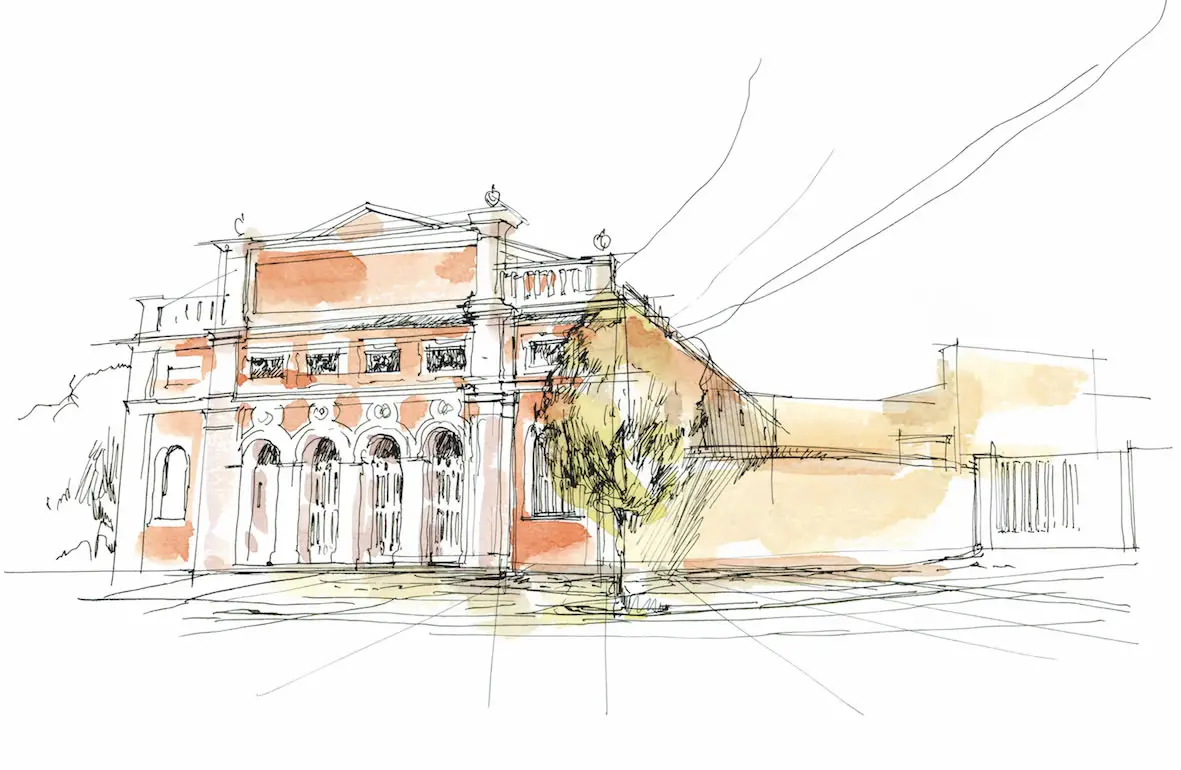
The result is an interesting mix of far-sighted entrepreneurship and a philanthropic spirit. After the war, Gaetano Marzotto was overwhelmed by requests for help and he tried his best to offer solutions: it is one of many examples that sheds light on the intelligence and humanity of this Italian industrialist. The estate became a sort of self-sufficient state within the state. The industrial and agricultural hub ensured the livelihood of its inhabitants, as well as being their only source of income. During this period, the new housing projects were differentiated according to type: detached single family homes for white collar workers, and multi-unit housing with communal gardens for the factory workers. The social activities and community centers brought all social classes together. The kindergarten, for example, was attended by all children, the sons and daughters of farmers, factory and office workers alike. The school fees were proportional to the income of the family, working more as a tax than a fee for a service. In 1949, the “Marzotto Sea Resort” was officially opened in Jesolo, accomodating 1,500 adults and children, for many of whom it was the first taste of a summer vacation by the sea.
The Fifties and Sixties were very interesting times. Influential personalities from a variety of directions visit Portogruaro, from politicians, to foreign observers and intellectuals. From just a few hundred sharecrop farmers in the 1930s, by 1962 the company had 10.000 employees. It is an Italian success story in which know-how, the development of a territory and above all consideration for the welfare of workers, have come together. A place in which people represent the future. The story of Villanova, of Valdagno and of the Marzotto family has started to spread overseas. The origins of the Santa Margherita wine estate are strongly connected with this vision, with this specific idea of a society. It begins with a thousand hectares of wild and poorly farmed land, a land in which the vine is not an important crop, but one of many and it starts to grow and develop in the backdrop an Italy whose consumption habits are changing. Wine is undergoing a transformation from being a mere staple – a quasi-food that for centuries served as a calorie supplement for those that labored the land – to being a product of quality. Gaetano Marzotto was one of the first to perceive this transformation and understand its potential. This is why he decided to focus on wines that can claim a denomination of origin, and why he focused on pursuing technological advancement even in the making of wine. Among the ‘innovations’ of those first pioneering years we find two game-changing introductions: the sparkling vinification of Prosecco, and the off-the-skins vinification (launched in 1961) of Pinot Grigio, the wine which has transformed Santa Margherita into a household name. These are two global products that have conquered important markets and opened up new paths for other successful Italian exports. To walk through Villanova Santa Margherita (named after Gaetano’s wife, Margherita Lampertico Marzotto) today serves as a reminder, it brings us back to a partially lost ambition towards a possible, people-oriented idea of progress. The houses in ordered rows, the grid-like road system, the town center clustering around the main square, the school, the pretty building that used to house the cinema, the omnipresence red of clay-brick – and further out, in progressively larger circles, the factory plants, and then the land, the water, the trees. It feels unusual and special, to see nature coexist alongside the work of man, and to see man not lose his nature.
It begins with a thousand hectares of wild and poorly farmed land, a land in which the vine is not an important crop, but one of many and it starts to grow and develop in the backdrop an Italy whose consumption habits are changing. Wine is undergoing a transformation from being a mere staple – a quasi-food that for centuries served as a calorie supplement for those that labored the land – to being a product of quality. Gaetano Marzotto was one of the first to perceive this transformation and understand its potential. This is why he decided to focus on wines that can claim a denomination of origin, and why he focused on pursuing technological advancement even in the making of wine. Among the ‘innovations’ of those first pioneering years we find two game-changing introductions: the sparkling vinification of Prosecco, and the off-the-skins vinification (launched in 1961) of Pinot Grigio, the wine which has transformed Santa Margherita into a household name. These are two global products that have conquered important markets and opened up new paths for other successful Italian exports. To walk through Villanova Santa Margherita (named after Gaetano’s wife, Margherita Lampertico Marzotto) today serves as a reminder, it brings us back to a partially lost ambition towards a possible, people-oriented idea of progress. The houses in ordered rows, the grid-like road system, the town center clustering around the main square, the school, the pretty building that used to house the cinema, the omnipresence red of clay-brick – and further out, in progressively larger circles, the factory plants, and then the land, the water, the trees. It feels unusual and special, to see nature coexist alongside the work of man, and to see man not lose his nature.
Words – Cristiano De Majo
Illustrations – Karin Kellner
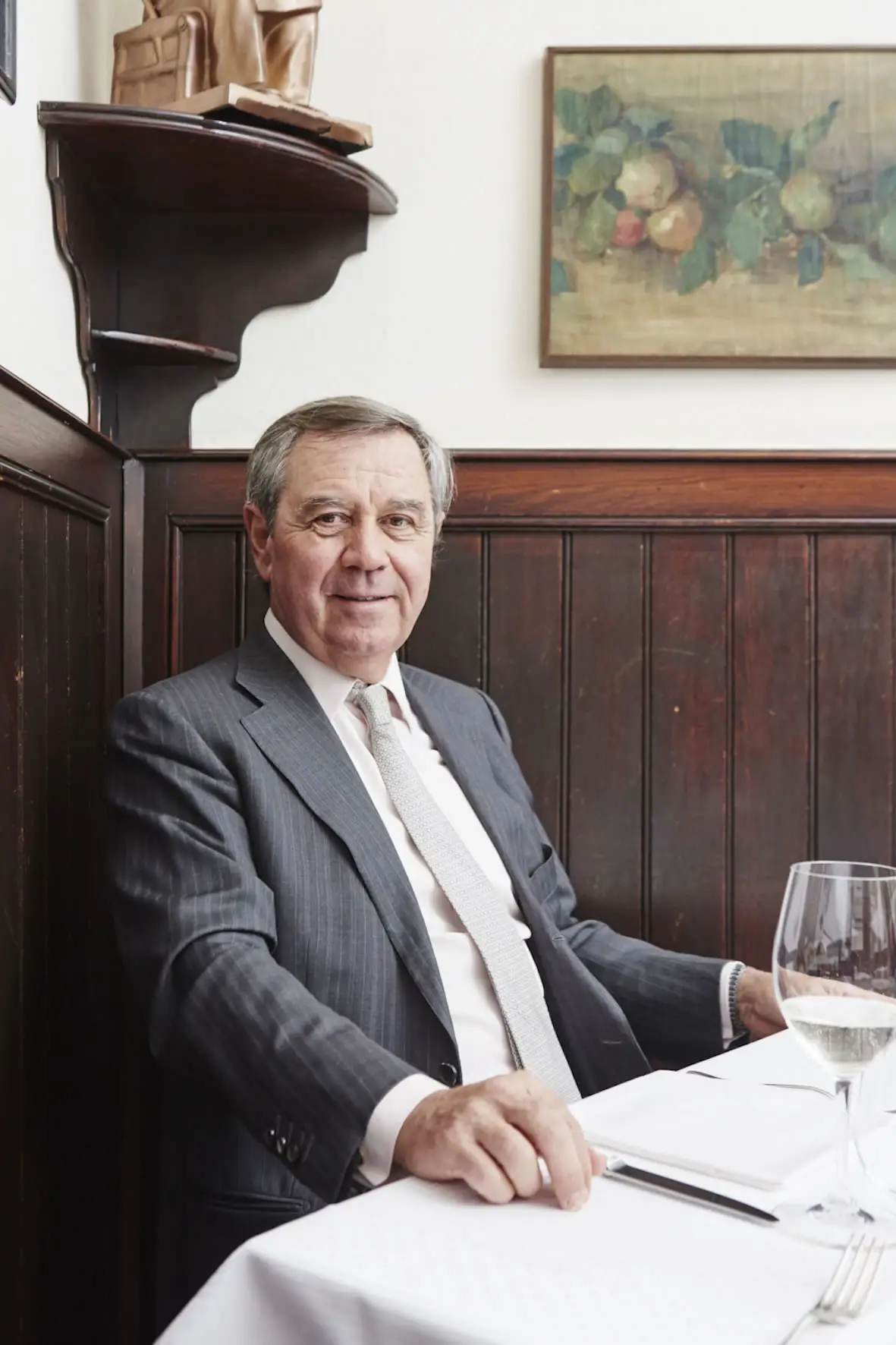
The story of Santa Margherita is fundamentally a love story. The Marzotto family’s love for their work, the company’s love for its territory of origin, the employees and workers’ love for the products. And the rest of the world’s love for its wines, a global synonym of Italian style at its best. A story that continues without pause, with many projects for the future. During a pleasant breakfast, we spoke about all this with Gaetano Marzotto, the company president.
Can you tell us how your story with Santa Margherita began?
There was a period in our childhood in which my brother Stefano and I would often go to Portogruaro to visit our grandfather, and eventually with my two younger brothers – Nicolò and Luca – and our father Vittorio Emanuele. During these visits we would go for long walks and he would share his passion with us and most of all his vision: which drove him to transform this marvelous countryside near the sea, which at the time was still swampy and mostly dedicated to hunting and fishing, into a sort of agricultural industrial district. From grapes he made wine, from cows he made milk, cheese, and yogurt, from sugar a sugar refinery, from flax the flax mill, and so on. It was a process that revitalized a very depressed area of Veneto, at the borders with Friuli, which, during the Thirties was suffering from a local recession as well as from the global economic depression of the time. My grandfather transformed the territory and created jobs. Before he stepped in, there were 200 sharecroppers working six months a year (following the rhythm set by land owners). He created 1,200 real jobs for agricultural workers that worked all year round.
Then, over time, we noticed that the products with most success were wines – as well as the glass factory, which is very important: we needed it to make bottles for wine, milk, and the fruit juices obtained from the orchards. Thus in Portugruaro a factory was born which today is a listed company known as Zignago Vetro. Passion and entrepreneurial enthusiasm has been our driving force together with a desire to create wealth and well-being. My grandfathers goal was not only to create an industrial framework, but also to promote a better social structure. In Portogruaro, but also in Valdagno, as in other places where he built businesses, my grandfather created schools, preschools and a series of social activities that allowed people to lead a serene life.
As a classic example of entrepreneurial passion combined with a solid welfare system within the company and sound historical roots, are these the driving forces that have brought Santa Margherita to where it is today?
Yes, a great passion for life, for doing, for creating well-being and wealth, for the production of good products. My grandfather was passionate about food and wine, and valued the traditions and culture surrounding the act of being at the table; he had a true love of conviviality, creating his own recipes paired with specific wines. He was also a very curious person, wherever he went he wanted to try the local wine. He liked Pinot Grigio, it had a pleasant taste and a coppery coloring as a result of being vinified with skins. The idea of removing the skins in order to obtain a clear, bright yellow Pinot Grigio immediately gained popularity for its freshness and elegant aroma.
Among other things, you reached global success. Can you tell us about the arrival of Pinot Grigio overseas?
It was a wine that had an enormous success in Italy first. Then, it happened that Tony Terlato, an American importer, was in Italy during the Seventies. He was a guest at the Principe di Savoia Hotel in Milan, where he was very good friends with the sommelier, and to whom he asked: “What is the most popular white wine in Italy, now?” The sommelier’s answer was: “Look, one of the wines that we sell the most and that has the most success, is the Santa Margherita Pinot Grigio.”
He tried it, and immediately fell in love with the wine. He hurried to Portogruaro. He waited there for three days before being received—no one knew him, actually—then he said: “If you give me this for the US, I’ll sign a 5-year contract and I’ll try to do my best.” We've been doing business together for 37 years now, first with Pinot Grigio and later all of our wines became very famous in the United States. And this year we decided to sell on our own on the US market: it is a crucial and exciting challenge.
This is a time in which the values upheld by brands are crucial, you cannot do business without them. Some companies are having to build theirs from scratch. What are the key values of Santa Margherita?
Quality, for sure. Along the entire chain: quality isn’t created in the cellar only, it starts with the soil, with the cultivation of grapevines. Undoubtedly, this is the feather in our cap.
Still, quality cannot prescind from investments. Our wine cellars represent a good balance between innovation and tradition: we take care of our grapes, without crushing them, without stressing them, we even do some things by hand. At the same time, we invest a lot in technology: when a quick vinification is needed, we can obtain it because we have the right machinery. Tradition, innovation, quality. We also believe in having good relationships with all our collaborators. We even have second and third-generation workers with us: we think that human relationships based on trust are crucial.
There are several other values: we do rely on a lot, for instance, on the ability we have of communicating – you can do excellent things, but if you keep them for yourself, it’s very hard for you to make it. Then, another key value for us, and by 'us' I mean both my family and the company, is avoiding to seek economic return in the short term. We act, we think and we invest looking towards future generations: we are the fourth generation of winemakers and the eighth generation working in the textile industry. Sometimes we experiment, and our managers tell us, “Are you really sure you want to invest in plots of land,” and the answer is always that we are, even though we are aware that the returns on investing in plots of land is quite low. However, we also know that if you have good soil, you can have good wines more easily. Maybe we won’t have an excellent return in the short term, but in the medium-long one we will obtain better wines, and the consumer will repay you in the end.
In dealing with the consumer, how much has the perception of wine changed over the years? We live in an era in which everyone seems to be a gourmet. It is really the truth?
Since Santa Margherita was founded, the perception of wine by consumers has undergone a revolution. Back in the day, wine was a simple aliment. Our workers, our farmers, our collaborators, they all used to leave their houses with a flask of wine, a piece of bread and a chunk of cheese. And by flask, I mean a 2-liter wicker wine bottle: everyone drank a lot more than today. Then, little by little, wine has been refined, improved, we’ve managed to obtain a better result. In Italy, we managed to have a far better result, we’re not the first sellers of wine in the U. S. by chance, it’s because Italians are very good at making wine. With Santa Margherita we express trust in a convivial, pleasant wine, which can be drunk everywhere in spite of cultural differences. Nowadays, people drink more responsibly, and they choose wines of higher quality. People love wine pairings, they choose their wine according to the food they eat, there are even restaurants in which you choose your wines first and your food after. This is all part of the so-called ‘wise pairing’ we are trying to promote with Santa Margherita.
The history of Santa Margherita is the history of an Italian brand with a firm territorial rooting which achieves global success thanks its values. A characteristic of Made in Italy is being able to export a certain lifestyle updating it to the times and places we do business with. Why, in your opinion, is the Italian lifestyle such a global success?
Because, basically, it’s a lifestyle that places the individual at the center, which privileges a good balance between work and leisure. If you look at some Anglo-Saxon cultures, the only thing that matters is how much you earn and how much you spend, while we support different values, that deal with the quality of life. And I mean several things when I say ‘quality of life’: the use of our spare time, friendships, the ability to enjoy the beautiful cities we live in, traveling. Our style is based more on being than on having. Maybe we’ll earn less than Americans, for instance, but we live better than them; provided with the same income level, in several Italian areas the quality of life is higher than in other countries. And we are exporting all this thanks to our products: not only wine, but also fashion, furniture, automobiles and lots of other things, especially food.
When tourists arrive in Italy, and they are more than 50 million a year, they recognize that with a moderate price they can drink fantastic wine and eat delicious food, in astonishing places. Following on this, a lot of foreigners established their residence in some Italian regions: the well-known example of Chiantishire, discovered by the Brits, is among the first manifestations of this phenomena, followed by Marche and Puglia, that are becoming very cool lately. Of course, there are also things which could be improved: we are not organized enough, we cannot rely on good infrastructures, our transport system isn’t developed enough. Actually, the birth of places where those who love Italy could live happily should be encouraged.
In your opinion how important is teamwork when it comes to exporting our lifestyle and consequently our products and companies?
At Santa Margherita, we have made extraordinary progress in several countries. First of all in Italy, where we became leaders with our Pinot Grigio but also with other wines, such as Prosecco, Müller-Thurgau, Chardonnay. This is due to the fact that we invested not only in the quality of our products, but also in their distribution: we have one of the best sales networks in the entire sector. We have been able to achieve an astonishing success in the US – and there is no such thing as a free lunch in this business – because our team works perfectly. The true challenge of the upcoming years will be replicating the same success in other regions. Actually, we have already started to work on this: Canada, the Caribbean, Europe. These are all great markets for us. And our importance is growing in Australia, Japan, Korea and China. I’ll repeat it: there is no room for improvisation, you need a solid team that is equipped for the challenges it will face, working together in order to reach a common goal.
Do any of the so-called 'new markets' intrigue you particularly or where you can see specific potentialities?
I am fascinated with the potentialities China and India have to offer. We need to work on the right formulas to export the Italian lifestyle to these places, not only food and wine I mean, but also the automotive industry, fashion, design. We see it every day with the fashion brands which have been able to sell remarkable quantities of products; I do think there is potential there for food and wine too. And this applies to us as well: the Chinese are very good at producing, they have incredible possibilities of exporting high-level products. I hope for a true and intense exchange of cultures and innovation.
This, if I may, reflects your grandfather’s curiosity, from which everything was born. I would like to ask you a further consideration about the U.S. and their long love story with Santa Margherita wines. Are there any further steps to be made?
We have the great chance of being our own importers in the U.S. and this will allow us to sell not only our Pinot Grigio, Prosecco and Chianti Classico, but all of our wines. I see enormous room for growth. An example: it seems that Americans know only Champagne, but when they try Franciacorta Ca’ del Bosco, they change their minds. American millennials love Prosecco.
Who can blame them, after all.
Testo – Federico Sarica
Foto – Andy Massaccesi, Giò Martorana